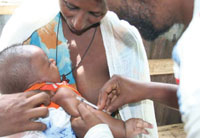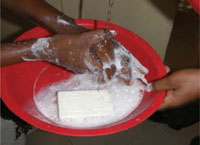2.2.3 Measures targeting the susceptible host
The measures described below help to protect the susceptible host either from becoming infected, or from developing the stage of infectious disease if they are exposed to the infectious agents.
Vaccination
You will learn more about vaccine-preventable diseases in Study Sessions 3 and 4 of this Module.
As you already know from Study Session 1, vaccination refers to administration of vaccines to increase the resistance of the susceptible host against specific vaccine-preventable infections. For example, measles vaccination helps to protect the child from measles infection, and BCG vaccination gives some protection from tuberculosis (Figure 2.4).

Chemoprophylaxis
Chemoprophylaxis is pronounced ‘keem-oh-proff-ill-axe-sis’; (‘chemo’ refers to medical drugs, and ‘prophylaxis’ means ‘an action taken to prevent a disease’).
Chemoprophylaxis refers to the drugs given to exposed and susceptible hosts to prevent them from developing an infection. For example, individuals from non-malarial areas who are going to a malaria endemic area can take a prophylactic drug to prevent them from developing the disease if they become infected with malaria parasites from a mosquito bite.
Maintaining a healthy lifestyle
Proper nutrition and exercise improves a person’s health status, supports the effective functioning of their immune system, and increases resistance to infection.
Limiting exposure to reservoirs of infection
Measures taken to decrease contact with reservoirs of infection include:
- Condom use to prevent transmission of HIV and other sexually transmitted infections (STIs).
- Use of insecticide treated nets (ITNs) over the bed at night, insect repellants and wearing protective clothing to prevent diseases transmitted by insect vectors.
- Wearing surgical or very clean gloves and clean protective clothing while examining patients, particularly if they have wounds, or the examination involves the genital area.
- Keeping personal hygiene, like taking a daily bath and washing your hands frequently. Hand washing with soap and water is the simplest and one of the most effective ways to prevent transmission of many communicable diseases (Figure 2.5). The times when hands must be washed are indicated in Box 2.4.

Box 2.4 When to wash hands with soap and clean water?
- After using the toilet
- After handling animals or animal waste
- After changing a diaper (nappy) or cleaning a child’s bottom
- Before and after preparing food
- Before eating
- After blowing the nose, coughing, or sneezing
- Before and after caring for a sick person
- After handling waste material.
Now you have many good ideas on what measures can be undertaken to prevent and control communicable diseases. However, you have to apply these methods effectively in order to prevent and control the most important communicable diseases in your community. But how do you identify these diseases? In the next section we will answer this question.
2.2.2 Measures targeting the mode of transmission
